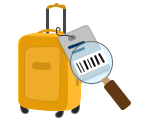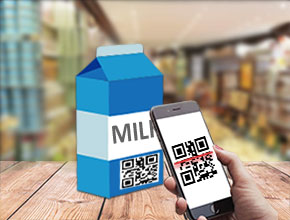Retail Business Barcode
It is used to identify the product and track its movement through the retail supply chain, from the manufacturer to the end customer, retail business barcodes are a critical component of modern retail operations, allowing for efficient and accurate management of inventory and sales data. They simplify the process of product identification, pricing, and tracking, enabling retailers to streamline their operations and provide better customer service.
Types of Barcode Scanner for a Retail Business
The best barcode scanner for a retail business will depend on the specific needs of the business, such as the size of the business, the types of products sold, and the volume of sales. It's important to do thorough research and consider all options before making a purchase.
-
Handheld Laser Scanners:
These scanners are very popular for retail businesses due to their speed and accuracy. They work well with most barcode types and can read barcodes from a distance. They are also relatively affordable, with prices ranging from around $50 to $300
-
CCD Scanners:
These scanners are similar to laser scanners but use LED lights to read barcodes. They are often more affordable than laser scanners, with prices ranging from around $30 to $150. However, they may not be as accurate as laser scanners and may require a closer distance to read barcodes.
-
Omni-Directional Scanners:
These scanners are designed to read barcodes from any angle and can read multiple barcodes at a same time. They are often used in high-volume retail environments, such as supermarkets or grocery stores, and can cost anywhere from $300 to $1,000.
-
Wireless Scanners:
These scanners connect to a computer or mobile device via Bluetooth or Wi-Fi, allowing for more flexibility in scanning barcodes. They are often used in retail environments where mobility is important, such as in-store inventory management or at outdoor events. Prices can range from around $100 to $500.
Working of Retail Business Barcode

- A manufacturer assigns a unique identification number to each product, which is registered with the global organization GS1.
- GS1 generates a corresponding barcode for the product, based on the Global Trade Item Number (GTIN) system.
- The barcode is printed on a label and attached to the product packaging.
- When the product arrives at a retail store, the barcode is scanned at the point of sale using a barcode scanner.
- The scanner reads the barcode and retrieves the product information, such as its price, description, and stock levels, from the retailer's database.
- The cashier verifies the product information and completes the sale.
- The barcode data is automatically recorded in the retailer's inventory management system, updating the stock levels and allowing for efficient restocking and ordering.
Difference of Retail Barcode from Others
The main difference between a retail business barcode and other barcodes is that retail barcodes follow a specific standard called the Global Trade Item Number (GTIN) system. The GTIN system is managed by the global organization GS1, which assigns unique identification numbers to products and generates the corresponding barcode.
Retail business barcodes are used extensively in the retail industry, as they allow for faster, more accurate checkouts and inventory management. When a barcode scanner reads a retail barcode, the system can instantly retrieve the product information, such as its price, description, and stock levels.
The information included in a retail business barcode can vary depending on the specific needs of the business, but the most common information is:
- Product code or SKU (Stock Keeping Unit) number: This is a unique identifier for each product or item in the inventory
- Product description: A brief description of the product or item.
- Price: The price of the product or item.
- Manufacturer's name: The name of the company that produced the product or item.
- Country of origin: The country where the product was made.
- Bar code type: The type of barcode used for the product.
Including this information in a retail barcode allows businesses to easily and accurately track inventory levels, monitor product movement, manage stock, and make sales transactions more efficiently. The barcode can be scanned at the point of sale using a barcode scanner to retrieve the product information and facilitate the sales transaction.
Types of Equipment to use in Retail Business Barcode:

A barcode scanner is used to read the barcodes on products. There are different types of barcode scanners, including handheld, stationary, and wireless scanners.
You will need to print barcode labels for your products. Barcode labels come in different sizes, materials, and adhesive types, so choose labels that are compatible with your products and environment.
You will need a barcode printer to print the barcode labels. There are different types of barcode printers, including thermal transfer and direct thermal printers.
A POS system is used to process transactions and track inventory. Many POS systems have barcode scanning capabilities, so you can scan barcodes directly into the system.
You may need barcode software to design and print the barcode labels. Barcode software allows you to create and customize barcodes, and print them on your barcode printer.
You will need a computer or mobile device to run your POS system and barcode software. Make sure your computer or device is compatible with the software and hardware you are using.
Overall, the equipment you need to use retail business barcodes will depend on the size and complexity of your business. It's important to choose equipment that is reliable, easy to use, and compatible with your existing systems and workflows.
Implementation Cost of Retail Business Barcode:
The cost of implementing a barcode system for a retail business can vary depending on several factors, including the size of the business, the number of products in the inventory, the complexity of the system, and the type of equipment and software required. Here are some factors that can impact the cost of implementing a retail barcode system:
- Barcode scanners: The cost of barcode scanners can vary depending on the type and quality of the scanners needed. Basic handheld scanners can range from $50 to $200, while more advanced scanners with features like wireless connectivity and long-range scanning can cost $500 or more.
- Barcode labels: The cost of barcode labels will depend on the size of the inventory and the type of label required. Labels can range from a few cents to several dollars each.
- POS software: Many retail barcode systems integrate with point-of-sale (POS) software to manage inventory and sales. The cost of this software can vary depending on the features and complexity of the software. Some software solutions are free or low-cost, while others can cost thousands of dollars.
- Implementation and training: Depending on the complexity of the system and the level of support required, implementation and training costs can range from a few hundred dollars to several thousand dollars.
- Ongoing maintenance and support: Ongoing maintenance and support costs can include software updates, equipment repairs, and technical support. These costs can range from a few hundred dollars to several thousand dollars per year.
Overall, the cost of implementing a retail barcode system can range from a few thousand dollars to tens of thousands of dollars, depending on the specific needs of the business. However, many retail businesses find that the benefits of implementing a barcode system, such as improved efficiency, accuracy, and customer service, can outweigh the initial investment.
Regulatory Requirements for Business Barcodes
Business barcodes can refer to a wide range of barcode applications, including product labeling, inventory management, and asset tracking. The regulatory requirements for business barcodes can vary depending on the country and industry in which they are being used.
In the United States, the Uniform Code Council (UCC) sets standards for business barcodes through its subsidiary, GS1 US. GS1 US is responsible for developing and maintaining the GS1 System, which includes the Global Trade Item Number (GTIN), a unique identification number used to identify products in the supply chain. The GS1 System also includes standards for barcode symbologies, barcode printing, and data content.
In Europe, the European Article Numbering Association (EAN) sets standards for business barcodes. The EAN is responsible for developing and maintaining the European Article Number (EAN), which is similar to the GTIN and is used to identify products in the supply chain. The EAN also sets standards for barcode symbologies, barcode printing, and data content.
Other industry organizations, such as the International Organization for Standardization (ISO), also set standards for business barcodes. ISO has established standards for barcode symbologies, barcode printing, and data content, including the ISO/IEC 15416 standard for barcode print quality.
Overall, the regulatory requirements for business barcodes are designed to ensure that products and assets are tracked and managed efficiently and accurately. These standards are typically set by industry organizations, such as GS1, EAN, and ISO, in consultation with government agencies and other stakeholders.